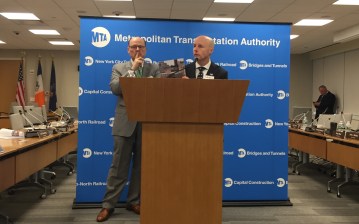Stuck With Slow Bus Service? Cuomo Is Completely Oblivious to Your Pain

You can tell Governor Cuomo doesn’t get on a New York City bus unless it’s for a photo-op about on-board USB ports.
The latest evidence came yesterday, after a coalition of transit advocates released a major report on the deterioration of bus service in New York City. With bus speeds declining, ridership has dropped 16 percent since 2002. In their “Turnaround” report [PDF], TransitCenter and other advocates outline proven techniques to improve bus service, pointedly noting that it will take concerted political leadership to reverse the decline of the city’s bus system.
Cuomo is the politician whose leadership is needed most. But Politico’s Dana Rubinstein reports that the governor blew off a question about improving bus service yesterday afternoon. “If people in Manhattan are choosing to jump on the subway because the subway is faster, because there’s traffic that a bus has to deal with,” he said, “that’s not an imprudent choice, right?”
In one sentence, the governor betrayed his ignorance of NYC’s bus system in several ways. Here are three of them.
Buses and trains don’t do the same things
The subway system is largely a radial network, with lines converging in Manhattan below 60th Street and extending out from there. It works well for an astounding number of trips, but New Yorkers still have to get places that the subway doesn’t reach efficiently. For these trips, there is no parallel subway service that people can just “jump on” instead of taking the bus.
Cuomo’s reference point is Manhattan, where subway coverage is the most extensive and bus ridership is declining the most. But even there, the only transit that will take you across town on much of the island is the bus. And crosstown bus routes are shedding riders too. Last year, major crosstown routes like the M23, the M66, and the M79 lost more riders than the boroughwide average of 5.1 percent.
Another way to appreciate the different trips served by trains and buses is to take a glance at the subway and bus maps for Queens. The subway map doesn’t even show a huge chunk of the borough — I rotated and scaled it here to make it more visually comparable to the bus map:
When was the last time the governor even looked at a bus map?
Millions of people still ride the bus
If some people are, in Cuomo’s formulation, making a “prudent choice” by abandoning the bus for faster options, that still does nothing for the huge number of New Yorkers who continue to ride the bus. People make more than two million bus trips in the city each weekday, and all those riders put up with slow, unreliable service. What is Cuomo going to do for them?
The bus routes with the most riders tend to be the ones where sluggish speeds and unreliability are the worst. The more passengers using a given bus route, the more prone it will be to slow travel times and bunching, thanks in large part to antiquated fare collection methods. These routes also tend to cover territory that the subway does not.
The governor’s theory about people ditching the bus for the train simply doesn’t apply to the vast number of New Yorkers who ride these routes and would benefit enormously from the recommendations in the Bus Turnaround report.
Traffic is not a force of nature
Currently, traffic congestion slows down buses a great deal, but it’s not a problem that, as Cuomo says, “a bus has to deal with.” It’s a problem that can be solved if policy makers — the governor first and foremost — set out to fix it. Camera-enforced bus lanes can clear paths for buses, and road pricing can lessen congestion throughout the city. But Albany has set limits on the number of bus routes where cameras can enforce dedicated lanes, and Cuomo has repeatedly refused to go to bat for any form of congestion pricing.
In the Bus Turnaround report, advocates urge the governor to “ensure that significant policy, planning and investment priority is accorded to the bus system, and not treat it as secondary to the subway.” New Yorkers need Cuomo to get a grip on the problems with bus service and take action.



